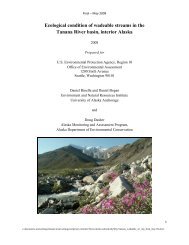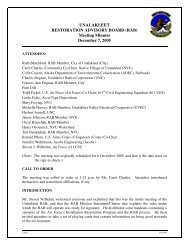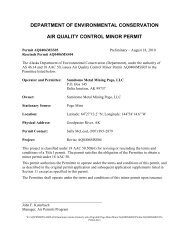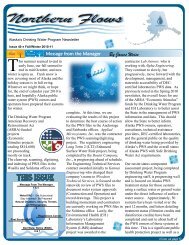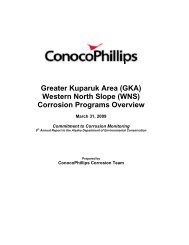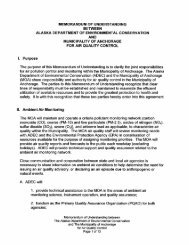2012 Ocean Ranger Guidebook Revision 3-7-12 - Alaska ...
2012 Ocean Ranger Guidebook Revision 3-7-12 - Alaska ...
2012 Ocean Ranger Guidebook Revision 3-7-12 - Alaska ...
Create successful ePaper yourself
Turn your PDF publications into a flip-book with our unique Google optimized e-Paper software.
<strong>20<strong>12</strong></strong> <strong>Ocean</strong> <strong>Ranger</strong> <strong>Guidebook</strong> 3-7-<strong>12</strong><br />
General Citations:<br />
State of <strong>Alaska</strong>:<br />
AS 46.03.740. OIL POLLUTION.<br />
A person may not discharge, cause to be discharged, or permit the discharge of petroleum, acid, coal or oil tar,<br />
lampblack, aniline, asphalt, bitumen, or a residuary product of petroleum, into, or upon the waters or land of the<br />
state except in quantities, and at times and locations or under circumstances and conditions as the department<br />
may by regulation permit or where permitted under art. IV of the International Convention for the Prevention of<br />
Pollution of the Sea by Oil, 1954, as amended.<br />
AS 46.03.745. HAZARDOUS SUBSTANCE RELEASE.<br />
Except for a controlled release, the reporting of which is the subject of an agreement with the<br />
commissioner under AS 46.09.010(b), a person may not cause or permit the release of a hazardous<br />
substance as defined in AS 46.09.900.<br />
18 AAC 75.300. Discharge or release notification; reporting requirements. (a)<br />
Subject to (b), (c), and (g) of this section, a person in charge of a facility or operation shall notify the department by<br />
telephone, and immediately afterwards send the department a written notice by facsimile, hand delivery, or first<br />
class mail, informing the department about a discharge or release of a hazardous substance at or from the facility<br />
or operation as follows:<br />
(1) as soon as the person has knowledge of a<br />
(A) discharge or release of a hazardous substance other than oil;<br />
(B) discharge or release of oil to water; or<br />
(C) discharge or release, including a cumulative discharge or release, of oil in excess of 55 gallons solely to<br />
land outside an impermeable secondary containment area or structure; and<br />
Definitions in AS 46.03.826<br />
"oil" means a derivative of a liquid hydrocarbon and includes crude oil, lubricating oil, sludge, oil refuse<br />
or another petroleum-related product or by-product;<br />
"hazardous substance" means<br />
(A) an element or compound which, when it enters into the atmosphere or in or upon the water<br />
or surface or subsurface land of the state, presents an imminent and substantial danger to the public<br />
health or welfare, including but not limited to fish, animals, vegetation, or any part of the natural habitat<br />
in which they are found;<br />
(B) oil; or<br />
(C) a substance defined as a hazardous substance under 42 U.S.C. 9601(14);<br />
Definitions in AS 46.09.900<br />
(4) "hazardous substance" means<br />
(A) an element or compound that, when it enters into or on the surface or subsurface land or water of<br />
the state, presents an imminent and substantial danger to the public health or welfare, or to fish,<br />
animals, vegetation, or any part of the natural habitat in which fish, animals, or wildlife may be found; or<br />
(B) a substance defined as a hazardous substance under 42 U.S.C. 9601 - 9657 (Comprehensive<br />
Environmental Response, Compensation, and Liability Act of 1980); "hazardous substance" does not<br />
include uncontaminated crude oil or uncontaminated refined oil;<br />
(6) "release" means any spilling, leaking, pumping, pouring, emitting, emptying, discharging, injecting,<br />
escaping, leaching, dumping, or disposing into the environment, except that "release" does not include a<br />
permitted release or an act of nature;<br />
193






